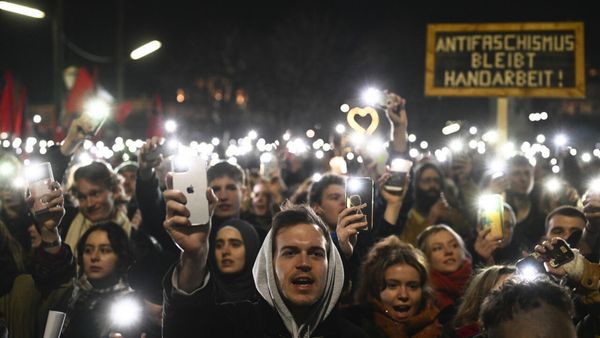
Updated at 3:30 p.m. ET on July 13, 2022
Fed up with Boris Johnson, Britain needs a new prime minister. It’s so fed up, in fact, that the next prime minister may look nothing like Johnson—that is, white, male, privately educated. The last time the Conservatives held a leadership contest, in 2019, the field of 10 contenders contained just one person of an ethnic-minority background and only two women. This time is remarkably different. Of those originally in contention, half were of ethnic-minority backgrounds and half were women. Until today’s initial selection, Britain could have had in Rishi Sunak or Suella Braverman its first Asian prime minister, in Kemi Badenoch its first Black prime minister, or in Nadhim Zahawi its first Kurdish and Muslim prime minister. (Zahawi has been eliminated, but Sunak, Braverman, and Badenoch remain in a field of six hoping to advance to the final stage of voting, slated for September 5.)
That such milestones could be achieved by a distinctly right-of-center party may seem odd—ironic, even—given the international left’s perceived patent on diversity and multiculturalism. But in Britain, the Conservatives have the best track record of political firsts, including the first Jewish prime minister in Benjamin Disraeli and the first female prime minister in Margaret Thatcher. Sajid Javid, whose recent resignation as health secretary led to the flood of Tory ministerial departures that toppled Johnson, was not only the first British Asian to put himself forward for the position of prime minister in 2019 but also the first ethnic-minority chancellor and home secretary. The Conservatives have produced the first female home secretary of an ethnic-minority background, the first Black chairman of one of Britain’s major political parties, and the first Muslim to attend the cabinet.
Conservatives haven’t always championed diversity in this way. Although the party elected its first lawmaker of Asian descent, Mancherjee Bhownaggree, in 1895, it would take nearly a century to do so again, this time with the election of Nirj Deva in 1992. Britain didn’t get its first British Asian woman in the House of Commons until in 2010 (when two were elected at once). Only five years ago did a British Asian ascend to one of the great offices of state for the first time (with Javid’s appointment as home secretary in 2018).
I reached out to Sunder Katwala, the director of British Future, a think tank that specializes in ethnicity and identity, to understand why the Conservative Party in particular has led Britain to this historic moment and what it reveals about the country’s sense of self.
“The pace of change of this development is absolutely extraordinary,” he said. In his view, this Conservative field represents “probably the most ethnically diverse contest for party leadership that has been seen in any major party in any democracy. For a party of the right of center, it’s off the scale.”
Diversity, after all, is generally regarded as a progressive shibboleth, not a Tory one. But as Katwala told me, this shift in representation among Conservatives did not happen organically but was the result of a years-long effort spurred by the former Conservative leader and prime minister David Cameron. When Cameron took over in 2005, the party claimed just two ethnic-minority members of Parliament, and he set out to ensure that his party more closely resembled the modern Britain it hoped to lead.
The next year, Cameron introduced a priority list of female and ethnic-minority candidates to be selected, many for safe Conservative seats. By the next election, the number of Conservative female MPs had risen from 17 to 49, and ethnic-minority MPs had increased from two to 11. Today, those figures stand at 87 and 22, respectively. By diversifying his party “at the top and from the top,” Katwala said, Cameron succeeded in transforming its image as a seemingly more inclusive and representative party, even if, in reality, it continued to lag behind the Labour Party in the diversity of its parliamentary caucus. In the House of Commons, more than half of Labour’s nearly 200 MPs are women and 41 are of ethnic-minority backgrounds—although Labour has so far failed to elect a woman or minority leader.
But Cameron’s diversity from above has not trickled down, and the Tory grass roots remain overwhelmingly male and white. Nor has the change of image necessarily resulted in more minority votes. During the last general election, the Conservatives stayed stuck at roughly 20 percent of the ethnic-minority vote compared with Labour’s 64 percent.
According to the party’s critics on the left, the Tories’ embrace of diversity among their senior ranks has hardly made Conservative politics more progressive either. Many of the party’s ethnic-minority leadership hopefuls are, in fact, among its most hard-line politicians on policy issues such as immigration, Brexit, and the rights of transgender people. The multicultural composition of the current leadership field seems only to have consolidated support for the Johnson government’s harsh plan of deporting asylum seekers to Rwanda in a bid to deter illegal migration—a policy all of the candidates back.
Faiza Shaheen, an economist specializing in inequality and social mobility and a former Labour Party parliamentary candidate, told me that the prevailing belief in progressive circles is that increased diversity naturally leads to policies that benefit the most disadvantaged communities. She regards this belief as misguided because the benefits have not materialized—rather, the reverse. “You have this weird conundrum when you have more Black and brown people in senior, powerful positions, but policies that disproportionately hurt people of color,” she told me. Shaheen also pointed out that although the Conservative Party has made progress in achieving more ethnic diversity, social class and economic status remain significant dividing lines between those with access to power and those without.
[Read: The ‘selectorate’ picking Britain’s next prime minister]
Another part of the paradox of the Tory leadership contest is that although the contenders themselves are representative of a more diverse Britain, the voters will be that far less diverse electorate of roughly 200,000 Conservative Party members. Still, notes Katwala, many of the leadership contenders’ personal stories offer an optimistic, patriotic view of Britain that goes down well with the party faithful.
“There is no doubt at all that the Conservative Party membership can vote for an Asian or Black candidate,” he said. “The only people who doubt that are liberal progressives who are projecting assumptions and stereotypes onto the Tory Party membership, and maybe onto the voters that switch to the Conservatives at the general election, to say, ‘They won’t do that.’”
The latest leadership polling of party members, which puts Badenoch and Sunak among the top contenders to the front-runner Penny Mordaunt, shows that they’d have very little hesitation about doing so.







